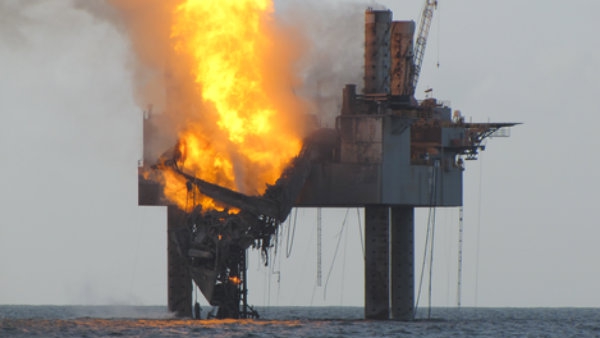A blowout and fire that began Tuesday at 8:45 AM at a gas well in the Gulf of Mexico, 55 miles off the coast of Louisiana in 154 feet of water, has been contained, according to the Bureau of Safety and Environmental Enforcement (BSEE), an arm of the US Department of the Interior. Damage to the rig was extensive and the nature of the environmental impacts of the fire, rig collapse and spill are not yet known. At the center of the accident is a blowout preventer, the same faulty technology that led to the Deepwater Horizon oil spill.
BSSE emailed a statement to EarthDesk this morning:
The Bureau of Safety and Environmental Enforcement (BSEE) and the U.S. Coast Guard confirmed this morning that the leaking natural gas well 55 miles offshore Louisiana has bridged over and the gas flow stopped. The fire has decreased to a small flame fueled by residual gas at the top of the well. Bridging is a well condition where small pieces of sediment and sand flow into the well path and restrict and ultimately stop the flow.
The well is owned by Hercules Offshore and operated by the Houston-based Walter Oil Gas Corporation (WOGC). Initial photos of the incident showed a tall plume of grey smoke emanating from the well structure. By Wednesday, fire had engulfed the rig. The BSSE issued an update about the response to “loss of control” at the well:
The natural gas well continues to fuel the fire on the rig. The derrick and drill floor structure has collapsed over the rig, and a very light sheen that dissipates quickly has been observed in the ocean.
The Wall Street Journal reported on the events leading to the fire and spill:
The crew tried to shut down the well using safety equipment known as a blowout preventer, which are valves meant to seal off pipes leading from oil and gas reservoirs, according to Hercules. But workers didn’t succeed in doing so before they had to evacuate for their own safety, the company said.
The failure of a blowout preventer was also integral to the Deepwater Horizon spill, and sparked a call for new regulations. Fuel Fix, an oil industry site, reported last May there would be “plenty of lead-time” for drillers to comply with the resulting Obama administration rules:
Obama administration officials at the Offshore Technology Conference have signaled they are prepared to give companies plenty of lead-in time to innovate new blowout preventers to meet the forthcoming requirements, manufacture the devices and install them on new and aging drilling vessels.
A “sheen that dissipates quickly,” reported at the site for 48 hours, is not necessarily cause for comfort. Often overlooked in the immediate description of spills are the “water soluble fractions” of the petrochemical family, such as the dissolved aromatic hydrocarbons napthalene and benzo(a)pyrene, which are inherently toxic and have known deleterious effects on marine life. Example research is here, here, here and here.
When asked about the status of the sheen, David Blackmon, spokesperson for WOGC, told EarthDesk this morning:
The last report we have on the sheen is from BSEE’s statement last night, which reported a small, light sheen that quickly dissipates. I’ll update you when we get a more current report on it.
At this writing, BSSE could not answer whether water sampling will be conducted.
The stated mission of well owner Hercules Offshore is “to be a preferred provider of incident-free, environmentally sound, reliable and cost-effective services to the oil and gas industry.” Meanwhile, some market analysts were abuzz about the accident. Financial media outlet Benzinga reported that the fire “presented a solid buying opportunity” for Hercules shares.










